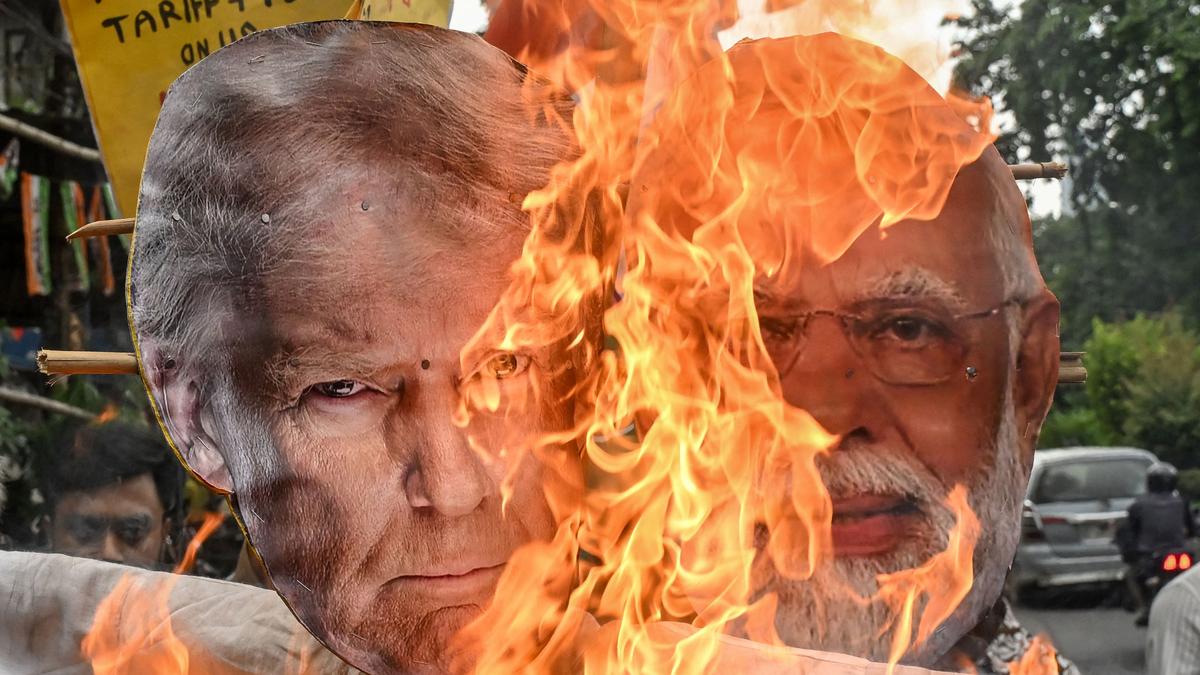U.S President Donald Trump upped the ante on tariff pressure on India, by saying that he would raise it more than the 25% already imposed on imports from a country which is now seen as a major U.S. ally. He specifically cited India’s high dependence on Russia for cheap crude imports as a major reason for his threat. He had also expressed displeasure over India’s dependence on Russia for military supplies.
“They (India) have always bought a vast majority of their military equipment from Russia, and are Russia’s largest buyer of ENERGY, along with China, at a time when everyone wants Russia to STOP THE KILLING IN UKRAINE — ALL THINGS NOT GOOD! INDIA WILL THEREFORE BE PAYING A TARIFF OF 25%, PLUS A PENALTY FOR THE ABOVE, STARTING ON AUGUST FIRST [sic],” Trump had said last month while announcing the tariffs.
Data shows that Mr Trump’s criticism of India for its oil and arms trade with Russia, while factually correct, lacks logic. India and China are not the only countries that continued purchasing energy from Russia after the Ukraine war began. In fact, data shows that the European Union’s energy imports from Russia have been higher than India’s during the war. Moreover, while India has increased its oil imports from Russia in recent years, many EU countries—particularly the Netherlands—have been importing large volumes of petroleum products from India. Further, the U.S. continues to imports a variety of goods, especially fertilisers, from Russia. Singling out a few countries for directly buying oil, while not putting the others who benefit indirectly in the same pedastal, defies logic.
Mr Trump’s criticism of India’s arms trade with Russia—made in the context of “everyone wanting Russia to stop the killing in Ukraine”—is also contradictory, given that the United States remains the largest arms supplier to Israel, whose actions in Gaza have been described as genocidal by several institutions.
While New Delhi has maintained a strong trade relationship with Moscow for decades, India began to import oil at a large scale a few days after the Russian invasion of Ukraine. In response to Russian aggression, the G7 countries led by the U.S. along with the European Union and the U.K. introduced a price cap on Russian oil exports with the intention of squeezing its revenues. This enabled India, a major crude importer, to source Russian oil at discounted rates.
The chart below shows Russia’s share in India’s oil imports since the beginning of the invasion of Ukraine.
There was a drastic increase in India’s imports of Russian oil between 2022 and 2023, with its share in overall oil imports doubling. In contrast, the share of imports from Iraq and Saudi Arabia, traditionally India’s biggest oil suppliers, declined. The MEA defended the increase in imports, saying that these were “actively encouraged” by the U.S. for the stability of global energy markets.
While India’s substantially increased oil imports from Russia have contributed to the latter’s trade revenues at a time of sanctions, China and the EU have imported more Russian crude. Of the 922 million euros that Russia earned from fossil fuel exports between February 2022 and August 2025, the EU contributed about 22% or 212 billion euros. The chart below shows the top 3 largest importers of Russia’s fossil fuels since the beginning of the invasion of Ukraine, as of August 2, 2025. In the last fortnight on average, the EU imported fossil fuels worth 43 million euros from Russia, according to the Centre for Research on Energy and Clean Air.
Some countries in the EU have also imported oil-based products from India in the same period, with the Netherlands having the highest share (19%) since the invasion of Ukraine . The chart below shows the Netherlands’ share in India’s exports of petroleum-based products over the past few years.
Another grouse raised by Mr Trump has been India’s dependence on Russia for military equipment supplies – borne out in the fact that over 50% of India’s arms imports since 2022 were from the Eurasian country. But India’s arms purchases from Russia have shown a steady decline since the 1990s, with increased imports from France, the U.K. besides the U.S. (a small share). The chart below shows the top 5 countries exporting arms to India since 2022.
Mr Trump also claimed that India’s trade with Russia showed that New Delhi did not “care how many people in Ukraine are being killed by the Russian war machine”. However, the U.S. has been the largest contributor of weapons to Israel, which recently engaged in warfare with Iran, besides attacking other neighbouring countries. As of August 5, 2025, Israel is responsible for the deaths of at least 60,933 people, mostly civilians, in Gaza – acts which have been termed as genocidal in nature by many institutions. As the chart below shows, 80% of Israel’s defence imports since 1949 have been from the U.S. Since 2022, all of Israel’s defence imports were from the U.S.
Source: Ministry of Trade and Commerce, Centre for Research on Energy and Clean Air, Stockholm International Peace Research Institute
Published – August 06, 2025 07:51 pm IST
